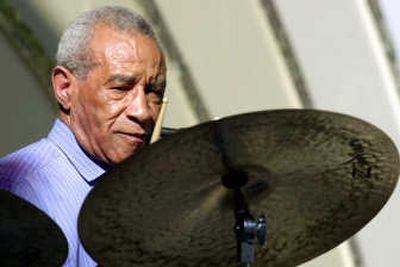Jazz drummer Max Roach dies at 83

Max Roach, the dazzling drummer who helped create the rhythmic language of modern jazz while expanding the expressive possibilities of the drums, died Thursday in a New York hospital. He was 83, and the cause of death could not be learned.
Roach was a founding architect of bebop, the high-speed, harmonically advanced music of the 1940s that helped elevate jazz from dance-hall entertainment to concert-stage art.
In dozens of landmark recordings with such musical giants as Dizzy Gillespie, Charlie Parker and Thelonious Monk – including a 1953 performance that has entered legend as “the greatest jazz concert ever” – he pioneered a new approach to drumming that remains the standard to this day.
When Roach was still in his 30s, fellow musicians named him the greatest jazz drummer ever. He remained an influential force for 60 years, expanding the borders of improvised music by incorporating elements of other artistic traditions, including African and Asian music, dance, poetry and hip-hop. He was among the first to use Afro-Cuban rhythms and unusual time signatures.
He led performances with as many as 100 percussion instruments on stage, but he also played minimalist solos using only the high-hat, a pair of cymbals mounted on a metal stand and worked with a pedal.
“Nobody else ever had the nerve to come out on stage with a cymbal under his arm and say, ‘This is art,’ ” jazz critic Gary Giddins told the Los Angeles Times in 1991. “Max Roach’s whole bearing says he is a musician to be treated like any great virtuoso. No drummer before him had ever achieved that.”
He later became a strong voice for racial equality through his recordings with singer Abbey Lincoln, to whom he was married for several years. In 1988, he was among the first jazz musicians to receive a MacArthur Fellowship, or so-called “genius grant.”
Roach’s most significant innovations came in the 1940s, when he and another jazz drummer, Kenny Clarke, devised a new concept of musical time. By playing the beat-by-beat pulse on the “ride” cymbal instead of on the thudding bass drum, Roach and Clarke developed a flexible, flowing rhythmic pattern that allowed soloists to play freely. The new approach also left space for the drummer to insert dramatic accents on the snare drum, “crash” cymbal and other components of the trap set.
By matching his rhythmic attack with a tune’s melody, Roach brought a newfound subtlety of expression to his instrument. He often shifted the dynamic emphasis from one part of his drum kit to another within a single phrase, creating a sense of tonal color and movement.
Virtually every jazz drummer plays in that manner today, but when Clarke and Roach introduced the new style in the 1940s, it was a revolutionary musical advance.
“When Max Roach’s first records with Charlie Parker were released by Savoy in 1945,” jazz historian Burt Korall wrote in the “Oxford Companion to Jazz,” “drummers experienced awe and puzzlement and even fear.”